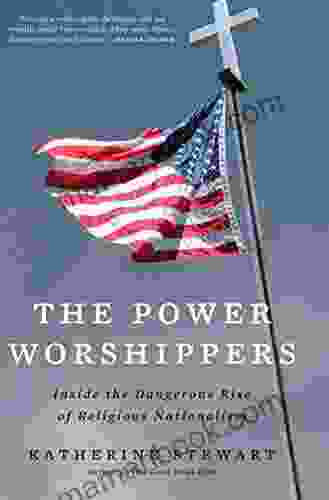Inside the Tangled and Dangerous Rise of Religious Nationalism

4.6 out of 5
| Language | : | English |
| File size | : | 4768 KB |
| Text-to-Speech | : | Enabled |
| Screen Reader | : | Supported |
| Enhanced typesetting | : | Enabled |
| X-Ray | : | Enabled |
| Word Wise | : | Enabled |
| Print length | : | 348 pages |
| Lending | : | Enabled |
The rise of religious nationalism is a worrying trend that is spreading across the globe. From the United States to India to Europe, religious groups are increasingly using nationalist rhetoric to promote their agendas and gain political power.
This phenomenon, a complex fusion of religion and political ideology, is often characterized by a belief in the superiority of one's religion, a glorification of the nation, and a rejection of pluralism and diversity. Its proponents seek to create a society in which their religious values and beliefs are enshrined in law and enforced upon the entire population.
Causes and Manifestations
Multiple factors contribute to the rise of religious nationalism. These include:
- Globalization and the erosion of traditional identities: The rapid pace of globalization and technological change has disrupted traditional ways of life and led to a sense of alienation and rootlessness. In this context, some people turn to religion and nationalism as a source of belonging and identity.
- Economic inequality and political instability: Economic inequality, corruption, and political instability create fertile ground for the growth of religious nationalism. When people feel they are being left behind economically or are threatened by political turmoil, they may be drawn to the promise of a better future offered by religious nationalist movements.
- Political opportunism: Politicians often exploit religious sentiment to gain political support. They may use religious rhetoric to appeal to their base, scapegoat minority groups, or justify authoritarian policies.
- Transnational religious networks: The rise of social media and other technologies has facilitated the spread of religious ideas and the formation of transnational religious networks. These networks can mobilize supporters and provide a sense of community for religious nationalists.
Religious nationalism manifests in various forms, including:
- Dominant religious narratives: Religious nationalists seek to establish a dominant narrative about the role of religion in society. They may argue that their religion is the only true religion or that it should be the foundation of the nation's laws and institutions.
- Religious laws and policies: Religious nationalists often advocate for laws and policies that promote their religious values. These may include laws restricting religious freedom, discriminating against minority religions, or enforcing religious dress codes.
- Religious violence: In some cases, religious nationalism leads to violence against minority religious groups or those who challenge religious authority.
Consequences and Dangers
The rise of religious nationalism poses several dangers to individuals, societies, and democracies around the world.
- Erosion of religious freedom: Religious nationalism often leads to the erosion of religious freedom and the suppression of minority religious groups. This can result in discrimination, persecution, and violence.
- Undermining of democracy and rule of law: Religious nationalism can undermine democracy and the rule of law. Religious nationalists may seek to establish a theocracy or to manipulate the legal system to promote their religious agenda.
- Social division and conflict: Religious nationalism can create deep social divisions and conflict. It can pit one religious group against another and lead to violence and instability.
- Radicalization and extremism: Religious nationalism can provide a breeding ground for radicalization and extremism. Individuals who feel alienated and frustrated may be drawn to extremist groups that offer a sense of purpose and belonging.
Countering Religious Nationalism
Countering the rise of religious nationalism requires a multi-faceted approach that addresses the underlying causes and manifestations of this phenomenon.
- Promoting education and critical thinking: Education and critical thinking skills are essential for countering religious nationalism. Individuals need to be able to critically evaluate religious claims and to recognize the dangers of religious extremism.
- Strengthening democratic institutions: Strong democratic institutions, including independent judiciaries, free media, and transparent elections, are essential for protecting religious freedom and preventing the rise of religious nationalism.
- Promoting religious tolerance and pluralism: Religious tolerance and pluralism are essential for peaceful and harmonious societies. Governments and civil society organizations should promote interfaith dialogue, understanding, and cooperation.
- Combating hate speech and discrimination: Hate speech and discrimination against religious minorities must be condemned and punished. Laws should be enacted to protect individuals and groups from religious discrimination.
- Addressing economic inequality and political instability: Addressing economic inequality and political instability can help to create a more just and equitable society, reducing the appeal of religious nationalism.
The rise of religious nationalism is a serious threat to religious freedom, democracy, and social cohesion around the world. It is a complex phenomenon with deep historical, social, and political roots. Countering religious nationalism requires a multi-faceted approach that addresses the underlying causes and manifestations of this phenomenon.
By promoting education, strengthening democratic institutions, encouraging religious tolerance, combating hate speech, and addressing economic inequality, we can work to prevent the rise of religious nationalism and build more just, inclusive, and peaceful societies for all.
4.6 out of 5
| Language | : | English |
| File size | : | 4768 KB |
| Text-to-Speech | : | Enabled |
| Screen Reader | : | Supported |
| Enhanced typesetting | : | Enabled |
| X-Ray | : | Enabled |
| Word Wise | : | Enabled |
| Print length | : | 348 pages |
| Lending | : | Enabled |
Do you want to contribute by writing guest posts on this blog?
Please contact us and send us a resume of previous articles that you have written.
 Top Book
Top Book Novel
Novel Fiction
Fiction Nonfiction
Nonfiction Literature
Literature Paperback
Paperback Hardcover
Hardcover E-book
E-book Audiobook
Audiobook Bestseller
Bestseller Classic
Classic Mystery
Mystery Thriller
Thriller Romance
Romance Fantasy
Fantasy Science Fiction
Science Fiction Biography
Biography Memoir
Memoir Autobiography
Autobiography Poetry
Poetry Drama
Drama Historical Fiction
Historical Fiction Self-help
Self-help Young Adult
Young Adult Childrens Books
Childrens Books Graphic Novel
Graphic Novel Anthology
Anthology Series
Series Encyclopedia
Encyclopedia Reference
Reference Guidebook
Guidebook Textbook
Textbook Workbook
Workbook Journal
Journal Diary
Diary Manuscript
Manuscript Folio
Folio Pulp Fiction
Pulp Fiction Short Stories
Short Stories Fairy Tales
Fairy Tales Fables
Fables Mythology
Mythology Philosophy
Philosophy Religion
Religion Spirituality
Spirituality Essays
Essays Critique
Critique Commentary
Commentary Glossary
Glossary Bibliography
Bibliography Index
Index Table of Contents
Table of Contents Preface
Preface Introduction
Introduction Foreword
Foreword Afterword
Afterword Appendices
Appendices Annotations
Annotations Footnotes
Footnotes Epilogue
Epilogue Prologue
Prologue Norm Foster
Norm Foster Angela Carr
Angela Carr Marla Cilley
Marla Cilley G C Timbrell
G C Timbrell Virgil Royer
Virgil Royer Steven Heighton
Steven Heighton Lee Strobel
Lee Strobel Raleigh Davis
Raleigh Davis Jinx Schwartz
Jinx Schwartz Jamilexis Gallardo
Jamilexis Gallardo Dirk Cussler
Dirk Cussler Kronos Ananthsimha
Kronos Ananthsimha Gus Garcia Roberts
Gus Garcia Roberts Jeff Kass
Jeff Kass Kathy A Zahler
Kathy A Zahler John Locke
John Locke Paul Kretschmar
Paul Kretschmar Jeanne St James
Jeanne St James Katherine Stewart
Katherine Stewart Kelvin Teo
Kelvin Teo
Light bulbAdvertise smarter! Our strategic ad space ensures maximum exposure. Reserve your spot today!

 Heath PowellMeditation Neville Goddard: Unlocking Hidden Powers and Manifestation Mastery
Heath PowellMeditation Neville Goddard: Unlocking Hidden Powers and Manifestation Mastery Andy HayesFollow ·6.4k
Andy HayesFollow ·6.4k Colby CoxFollow ·17.4k
Colby CoxFollow ·17.4k Christopher WoodsFollow ·12.9k
Christopher WoodsFollow ·12.9k Arthur Conan DoyleFollow ·9.3k
Arthur Conan DoyleFollow ·9.3k Deacon BellFollow ·12.3k
Deacon BellFollow ·12.3k Dwight BlairFollow ·7.1k
Dwight BlairFollow ·7.1k Gage HayesFollow ·16k
Gage HayesFollow ·16k Hugh ReedFollow ·5.7k
Hugh ReedFollow ·5.7k

 Ernest Powell
Ernest PowellBenefits of Corporal Punishment: A Review of the...
Corporal punishment is a form of physical...

 Bobby Howard
Bobby HowardThe Development and Significance of African American...
African American...

 Guy Powell
Guy PowellDown Girl: The Logic of Misogyny - A Comprehensive...
In her groundbreaking work,...

 Forrest Blair
Forrest BlairThe Bikini Changing Room: A Micro Mini Romance
In the heart of...
4.6 out of 5
| Language | : | English |
| File size | : | 4768 KB |
| Text-to-Speech | : | Enabled |
| Screen Reader | : | Supported |
| Enhanced typesetting | : | Enabled |
| X-Ray | : | Enabled |
| Word Wise | : | Enabled |
| Print length | : | 348 pages |
| Lending | : | Enabled |














